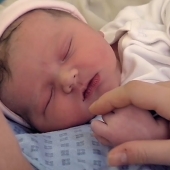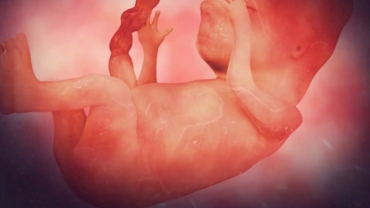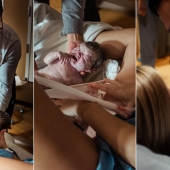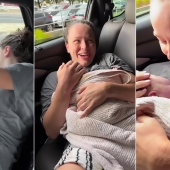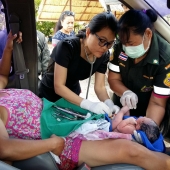
Katie Ferraro had already defied the odds, becoming pregnant with naturally fertilized quadruplets. She had undergone genetic testing that showed all four babies appeared healthy. Katie’s situation are either on bed rest or live in a special hospital unit.
Photo credits: Fourtified Family
Meanwhile, a large team of caregivers assembled on the fourth floor of Sharp Mary Birch Hospital for Women & Newborns. They were there to ensure all necessary resources could be mobilized to deliver Katie’s babies at a moment’s notice. Nurses and doctors from the hospital’s various units — High-Risk Pregnancy, Labor and Delivery, Surgery, Anesthesia, Respiratory Therapy, Maternal Infant Services and Neonatal Intensive Care — gathered together, reviewing details to ensure the safest possible delivery.
Photo credits: Fourtified Family
Katie was monitored several times each week by her doctor, Joanna Adamczak, and at the hospital’s Antenatal Testing Department. During those visits, issues could have been identified that would have required hospital admission for more intensive monitoring, or even an immediate C-section. Another possibility was that Katie could go into labor in the middle of the night and come in through the hospital’s Triage Department.
Photo credits: Fourtified Family
The only thing the caregivers knew for sure was that the exact delivery day and time was unpredictable — so they needed to be prepared. With the holidays approaching, it was especially critical to ensure on-call staff were at the ready and a notification plan was in place.
Photo credits: Fourtified Family
The first step was identifying the teams needed in the operating room (OR). Each baby would have an advanced life support team to care for them immediately after delivery. Three of these teams would receive babies in a resuscitation room adjacent to the OR. This room has all of the equipment necessary to warm the babies and help them breathe if needed. Space limitations meant the fourth team would stay in the OR with one of the babies. The OR would need to be heated to 85 degrees and special infant warmers would be brought in to keep each baby’s body temperature up.
Photo credits: Fourtified Family
Dr. Adamczak would have another doctor assisting her with the surgery, and an anesthesiologist and neonatologist would be on-hand. Multiple surgical technicians, therapists and other staff members would be there, and the hospital’s Level III Neonatal Intensive Care Unit (NICU) needed to be ready to admit four tiny patients all at once.
Photo credits: Fourtified Family
Then there was the issue of identifying which baby was which. In addition to numbered hats, the babies would each get color-coded umbilical clamps and medical tape so caregivers could keep them straight.
Photo credits: Fourtified Family
At 11:30 am, Katie underwent her scheduled C-section surrounded by a 20-person team. According to hospital staff, the plan was executed successfully and 24 minutes later, Charlie, Claire, Henry and Dillon were born — each healthy and born a minute apart.
Photo credits: Fourtified Family
The babies measured between three and four pounds and were 15 to 18 inches long. Only two babies, Henry and Dillon, required umbilical catheters, which help monitor blood pressure and allow fluids and medicine to be given. All four babies were taken to the NICU, and Katie met her new bundles of joy a short time later. She was discharged from the hospital after four days.
Photo credits: Fourtified Family
After some recovery, Katie reunited again with her babies in the NICU as they were breathing on their own and strong enough to be held for the first time. With the help of technology, Katie’s family and friends nationwide were able to see the babies through password-protected cameras placed near each baby’s bedside for monitoring. The four babies were able to go home once their weight increases and body temperatures were maintained.


